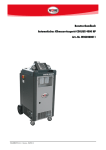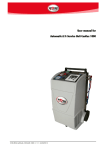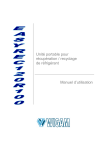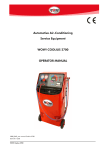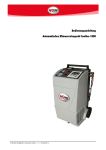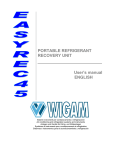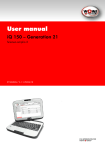Download User's manual COOLIUS 4000 HP automatic a/c service unit Art.
Transcript
User’s manual COOLIUS 4000 HP automatic a/c service unit Art.-No.W050200011 2154-ENG / Version 02/2014 CONTENTS Safety precautions ................................................................................................................................................................... 2 Layout drawings ..................................................................................................................................................................... 3 Hydraulic diagram .................................................................................................................................................................. 5 Electric diagram ...................................................................................................................................................................... 6 Legend .................................................................................................................................................................................. 7 1 Introduction to recovery unit COOLIUS-HP ........................................................................................................................ 8 1.1 Technical specifications ................................................................................................................................................ 8 2 Components description and standard equipment.............................................................................................................. 8 2.1 High vacuum pump ..................................................................................................................................................... 8 2.2 Refrigerant charging pump ........................................................................................................................................... 8 2.3 Refrigerant bottle ......................................................................................................................................................... 8 2.4 Distiller/Separator........................................................................................................................................................ 8 2.5 Compressor ................................................................................................................................................................ 9 2.6 Filters drier .................................................................................................................................................................. 9 2.7 Flexible hoses .............................................................................................................................................................. 9 2.8 Quick coupler valves .................................................................................................................................................... 9 2.9 Printer ......................................................................................................................................................................... 9 2.10 Control module ........................................................................................................................................................... 9 3 Preparing unit COOLIUS-HP for operation ...................................................................................................................... 11 3.1 Checking the vacuum pump oil level ........................................................................................................................... 11 3.2 Turning COOLIUS-HP unit on for the first time ............................................................................................................. 11 3.3 Filling refrigerant into the internal bottle ...................................................................................................................... 12 4 Using unit COOLIUS-HP .............................................................................................................................................. 13 4.1 Refrigerant recovery ................................................................................................................................................... 13 4.2 Vacuum + Vacuum Test ............................................................................................................................................. 14 4.3 Olio / Uv – Refrigerant charge .................................................................................................................................... 14 4.4 Automatic cycle ......................................................................................................................................................... 16 4.5 Flushing .................................................................................................................................................................... 18 4.6 Checking the A/C system operating pressures .............................................................................................................. 19 4.7 Disconnecting the unit from the A/C system ................................................................................................................. 19 4.8 Setting Menu ............................................................................................................................................................. 19 5 Service procedures ...................................................................................................................................................... 21 5.1 Emptying the internal refrigerant bottled ...................................................................................................................... 21 5.2 “Zero” scale check ..................................................................................................................................................... 21 6 Routine maintenance ................................................................................................................................................... 22 6.1 Material for routine maintenance ................................................................................................................................ 22 6.2 Periodic operations .................................................................................................................................................... 22 6.3 Changing the vacuum pump oil .................................................................................................................................. 22 6.4 Replacing the filter drier ............................................................................................................................................. 23 7 Troubleshooting .......................................................................................................................................................... 25 8 Accessories and spare parts .......................................................................................................................................... 26 9 Weight and dimensions ................................................................................................................................................ 26 1 - 32 Safety precautions This equipment is designed for trained personnel only, who must know the refrigeration fundamentals, cooling systems, refrigerants and possible damage that pressurized equipment may cause. Only use refrigerant R134a. The unit must not be used with a different refrigerant than the one it has been designed for. Carefully read the instructions contained in this manual; strict observance of the procedures described is fundamental to the operator’s safety, the perfect state of the unit and constant performances as declared. The unit must always work under the operator’s direct supervision Before performing any operation, make sure that the hoses used for connections have been previously evacuated and that they do not contain non-condensable gases. Avoid skin contact; the low boiling temperature of the refrigerant (about -30°C) can cause freezing. Avoid breathing refrigerant vapours. It is recommended to wear suitable protections like safety glasses and gloves; contact with refrigerant may cause blindness and other personal injuries. Do not smoke near the unit and do not operate near open flames and hot surfaces; the high temperatures decompose the refrigerant releasing toxic and caustic substances which are hazardous for the operator and the environment. Always make sure that the unit is connected to a suitably protected mains supply provided with an efficient earth connection. Before performing maintenance operations or when the unit will not be used for a long period of time, turn the unit off by turning the main switch to 0 and disconnect the power supply cord; absolutely follow the sequence of operations. Operate the unit only in locations with suitable ventilation and a high number of air changes. Before disconnecting the unit, make sure that the cycle has been completed and that all valves are closed in order to avoid release of refrigerant to the atmosphere Never fill any tank with liquid refrigerant to more than 75% of its maximum capacity. During operations avoid release of refrigerant to the environment; this precaution is required by international environmental standards and is essential to avoid difficult leak detection in a refrigerant polluted environment. Protect the unit from dripping. Do not expose the unit to direct sunlight, rain and to the inclemency of the weather. Do not modify the calibration of safety valve and control systems. If you recover refrigerant from a cooling system equipped with a water evaporator and/or condenser, it is necessary to drain water from the evaporator and/or condenser or to keep the circulation pump running during the entire recovery operation in order to avoid frosting. Disconnect the unit from the power supply if not used. General information Perform a good vacuum cycle before charging refrigerant into the system! Perform the refrigerant charging phase after having charged oil or UV! Empty the used oil bottle before starting the recovery phase! WARNING! If you do not pay attention to the above safety precautions, you could damage the recovery unit and the car A/C system! 2 - 32 Layout drawings Picture 1 3 - 32 Picture 2 4 - 32 Hydraulic diagram Picture 3 5 - 32 Electric diagram Picture 4 6 - 32 Legend 1 Solenoid valve – oil discharge line 48 Oil discharge bottle 2 Solenoid valve - recovery line 49 Refrigerant charge pump 4 Solenoid valve - vacuum line 50 Oil/UV charging bottle 6 Vacuum pump 51 Plastic cover 7 Compressor 52 Frame 9 Compressor starting condenser 53 Front door 10 Vacuum pump oil filler plug 54 Power cable 11 Vacuum pump sight glass 55 HIGH quick coupler 12 Vacuum pump oil drain plug 56 LOW quick coupler 13 Solenoid valve - refrigerant charging line 57 Manual discharge valve on the distiller 14 Heater belt with thermostat on the bottle 59 Oil return hose to compressor 15 Pressure transducer 60 Vibration damping feet on the scale 16 Spring for heater belt 61 Condenser with fan 17 Safety pressure switch 62 Remote control witch for recovery compressor 18 Main power switch 64 Thermal paper roll 19 Solenoid valve - oil/UV charging line 65 Fuse on outlet (10A) 20 Solenoid valve - pressure return to compressor 66 Distiller coil inlet tube 21 Liquid valve on the bottle 67 Distiller coil outlet tube 22 Refrigerant charge hose (bottle-pump) 68 Rear door 23 Vapour valve on the bottle 69 Handle 24 Power outlet (with fuse) 70 Load cell - 100 kg (refrigerant) 25 Condenser / bottle connecting hose 71 Load cell - 5 kg (oil discharge) 26 Capillary hose connecting LOW valve to LP gauge 72 Load cell - 5 kg (oil charge) 27 Capillary hose connecting HIGH valve to HP gauge 73 Control board 28 Refrigerant charge hose (pump-valve block) 74 Check valve - recovery line 29 Oil discharge capillary tube 75 Check valve – compressor delivery line 30 Refrigerant charge pump motor 76 Check valve – refrigerant charging line 31 Complete refrigerant bottle 77 Check valve – oil discharge line 32 Front wheel with brake 78 Check valve – oil charging line 33 Rear wheel Ø 250 79 Check valve - compressor delivery line (condenser) 34 Safety pressure switch on refrigerant charging line 80 Filter drier 35 Oil injection capillary tube 81 Filter drier 36 Hose - pressure return to compressor 82 Manual valve - LOW 37 Compressor/compressor oil separator connecting hose 83 Manual valve - HIGH 38 Valves assembly - distiller connecting hose 84 LP gauge 39 Safety switch capillary hose 85 HP gauge 40 Vacuum pump hose 86 Printer 41 Compressor suction hose 87 Electric feeder 42 Distiller/filter F1 connecting hose 88 Service connection for compressor evacuation 43 Distiller / separator 89 Bottle service connection 44 Distiller/filter F2 connecting hose 90 Bottle service connection (1/4” SAE) 45 Oil separator – complete compressor 91 LOW flexible hose 46 Flow regulation valve with hoses 92 HIGH flexible hose 47 Handle support 93 Safety valve 7 - 32 1 Introduction to recovery unit COOLIUS-HP Unit COOLIUS-HP permits quick and efficient recovery of refrigerant from the A/C system, refrigerant recycling, system evacuation, check for tightness, additive or lubricant injection, the subsequent charge with refrigerant and measurement of the operating pressures. Unit COOLIUS-HP permits to control all functions by means of 3 electronic scales (Refrigerant, Discharged Oil from A/C system, new Oil/Uv), 1 pressure transducers. 1.2 Technical specifications Refrigerant Maximum storage capacity R134a 40 kg Refrigerant supply 4 kg Maximum recovery rate 1,0 kg/min Maximum oil capacity 500 g Oil supply 50 g Power supply 230/1/50 Power input 1400 W Storage temperature -10 ÷ +50 °C Working temperature 0 ÷ 40 °C Protection degree Noise level IP24 < 70dB (A) Maximum refrigerant charge The maximum refrigerant quantity available for charging is calculated by subtracting 4 kg from the weight of the refrigerant contained in the bottle and indicated on the display max kg for charging = kg in bottle - 4 kg 2 Model Couplers and connections COOLIUS-HP 1/4” SAE with quick couplers Components description and standard equipment 2.1 High vacuum pump Essential component for extracting from the cooling system the residues of technical gases used for pressing, ambient air and vapour contained in it as well as water possibly formed through vapour condensation. The high vacuum pump the unit is equipped with is rotary vane type, lubricated by oil injection. 2.2 Refrigerant charging pump Rotary gear pump enables to have high refrigerant charging rates 2.3 Refrigerant bottle Maximum capacity Weight of empty bottle kg kg 40 22 It is provided with two connections, one of which with tube (liquid refrigerant) and one without tube (vapour refrigerant), safety valve and heater belt with thermostat. The non condensable gases discharge is controlled automatically by the software. 2.4 Distiller/Separator Single body construction, featuring: Distillation chamber with automatic flow control Separating chamber for the oil removed from recovery compressor and return 8 - 32 Heat exchanger chamber outlet gas / recovered refrigerant 2.5 Compressor Compressor is of the hermetic type 2.6 Filters drier Filters are anti-acid and have a water absorption capacity of 40 g of water. The can filter more than 300 kg of fluid. 2.7 Flexible hoses Their flexibility assures easy connection in any situation. They withstand A/C system operating pressures and maintain their passage section even when operating in vacuum. Unit COOLIUS-HP features hoses with quick coupler valves. Inner and outer hoses are in conformity with SAE J2916 standard. 2.8 Quick coupler valves Mounted on the hose ends and provided with a coloured operating ring (blue = low pressure, ref. 91; red = high pressure, ref. 92) for quick identification. 2.9 Printer The printer allows to print a report on paper with the values programmed by the operator and executed by the unit, with the possibility to re-print the report. Use paper (cod. n° 0764 95 002) as spare part. 2.10 Control module The unit is equipped with a large 7”color display, on which you will find the following information (Picture 5): Micro SD-Card connector Recovery function Oil Charge / Refrigerant charge function Vacuum function Arrow UP Arrow DOWN Access to Menu Exit key (Back) Auto function Start / Stop key Picture 5 9 - 32 Access to the Refrigerant Recovery function Access to the Vacuum function Access to the Oil charge/ Refrigerant charge function Standby – Access to the Menu for the modification of the unit’s settings parameters During a function setting – Back to the standby screen (during refrigerant charge, press for more than 1 second) During Refrigerant charge setting – Access to the Database Standby – Access to the Automatic function During a function – Start and end of the function During a function under way – if pressed for more than 3 seconds, it stops the function for emergency When pressed singly – enables to shift through the various ranges and modify the numerical values When pressed both at the same time – Start of the Flushing function 10 - 32 3 Preparing unit COOLIUS-HP for operation WARNING! The presence of the synoptic sticker does not exempt the operator from carefully reading this manual and strictly observing the described procedures. 3.1 Checking the vacuum pump oil level Before checking the oil level, the unit must be placed on a level surface and its power supply must be turned off. The user must check that the vacuum pump oil level covers half of the sight glass (see drawing below). 3.2 Turning COOLIUS-HP unit on for the first time 1. Place the 87 switch on position 1 2. The unit will automatically ask for the interface language; select the language by means of the arrows and confirm with . 3. Then, the zeroing of all the scales will start. The process is completely automatic and will take about 1 minute. 4. At the end of the procedure, the values of the scales will appear on the display. R 1 3 4 a 1 0 : 3 4 0 0 . 0 0 0 k g Ξ 8 / 1 0 / 1 2 ▼ 0 g ▲ 0 g Ξ Standby screen 1 O l i o i n O l i o o u t Standby screen 2 5. The next times you will turn the unit on, the display will show the software and hardware version of the unit and the standby screen will appear right away. 11 - 32 3.3 Filling refrigerant into the internal bottle The unit is supplied with no refrigerant inside. It is thus necessary to follow the below procedure to fill the exact quantity of refrigerant into the refrigerant bottle. 1. Place the bottle containing refrigerant so that liquid refrigerant will come out (bottle with tube upright, bottle without tube upside down). 2. Connect the male LP connection (supplied in the kit) to the refrigerant bottle (only in case the bottle is not equipped with a connection). 3. Connect the quick coupler ref. 56 (blue) to the bottle containing refrigerant. Open the hand-wheel of the coupler. 4. Open the 82 valve and close the 83 valve. 5. Make sure that the valve on the external bottle is closed. 6. Press the Vacuum key on the control module 7. Set a vacuum time of 5 minutes by means of the V T i m a c u u arrows m e 8. Press the 5 ‘ key to start the function and wait for the end of it (beep) 9. Once the vacuum cycle is completed and you are back in the standby screen, slowly open the valve of the bottle containing refrigerant 10. Press the Recovery key 11. Set the refrigerant quantity to recover (we suggest 5.000 kg) by means of the R R 1 3 4 12. Press the e c o v a e r y 5 . 0 0 0 k arrows g key to start the function. 13. Wait until the recovery cycle is completed. A beep will let the user know that the cycle is over and the quantity of recovered refrigerant will be displayed. IMPORTANT! In this moment, there is refrigerant in the hoses. Continue the procedure in order to prevent gas dispersion in the environment 14. Close the valve on the bottle containing refrigerant 15. Start a new recovery cycle set on ALL R R 1 3 16. Press the 4 e c o v e a r y A L L key to start the function. 17. Wait until the recovery cycle is completed; a beep will let the user know that the cycle is over and the quantity of recovered refrigerant will be displayed. 18. Disconnect the hose from the bottle 12 - 32 4 Using unit COOLIUS-HP 4.1 Refrigerant recovery WARNING! During recovery, regulate the 82 and 83 valves on the control panel, so that the input pressure never rises over 5 bar 1. Turn on the engine with closed hood 2. Turn the air-conditioner on and have it run for some minutes 3. Open the hood and set the air-conditioner fan to maximum speed 4. Have the vehicle engine run slowly (800 - 1200 revolutions/min) for a few minutes 5. Turn the vehicle engine off and have the air-conditioner fan run at maximum speed and start recovery operations the 6. Connect the hoses to the A/C system which needs a maintenance. Open the hand-wheels on the couplers. 7. Turn the 87 switch to position 1. 8. Open the 82 and 83 valves according to how the connection on the system was made 9. Press the Recovery key R R 1 3 4 e c o v e r a y A L L 10. The unit sets the recovery function on ALL by default: in this way, the unit recovers all the refrigerant there is inside the car. 11. Press the key to start the function. During the recovery cycle, the recovered refrigerant quantity appears on the display. R 1 R e c 3 4 a . u n d e r 0 . 0 w a y 0 0 k g 12. In case of emergency, it is possible to leave the function by pressing the STOP key for more than 3 seconds. 13. During the cycle, the unit performs the automatic oil discharge O i l d i s c h a r g e 0 g 14. Wait until the recovery cycle is completed; a beep will let the user know that the cycle is over and the quantities of recovered refrigerant and oil will be displayed. R 1 3 4 O l i o a 1 O u t . 1 0 0 k 1 0 g 13 - 32 g WARNING! Do not pollute environment with oil; it is a special waste and must be disposed of according to the regulations in force. 4.2 Vacuum + Vacuum Test 1. Connect the hoses to the A/C system which needs a maintenance 2. Turn the 87 switch to position 1. 3. Open the 82 and 83 valves according to how the connection on the system was made 4. Press the Vacuum key V a c u T i m e u m 3 5. Set a vacuum time by means of the 0 ‘ arrows. We suggest a vacuum time of at least 30 minutes. 6. Press the key to start the function. (In case of emergency, it is possible to leave the function by pressing the STOP key for more than 3 seconds) 7. When the vacuum cycle is over, the test phase starts to check the possible presence of leaks in the A/C system. 8. When the vacuum test is over, or if there are leaks, a beep will inform the operator. The display will show the information on the cycle just performed. V a c u u m V a c u u m 3 t e s t 0 ‘ O K 4.3 Olio / Uv – Refrigerant charge 1. Connect the hoses to the A/C system which needs a maintenance 2. Turn the 87 switch to position 1. 3. Open the 82 and 83 valves according to how the connection on the system was made WARNING! Always perform the charging function with a system which has been previously evacuated. In case the evacuation has not been effected correctly, the unit will inform the user by means of an alarm 4. Press the Charge key 5. The operator will be asked to select the type of charge: whether it will be effected through a single hose (blue or red) or whether it will be effected through both hoses. This enables the unit to calculate the correct value of the pre-charge (when it is set). 2 1 h h o o s s e e s L + ▲ ▼ H 14 - 32 6. Confirm with O i l O i l and then the screen for setting the oil/UV quantity will appear M a x S A M E 1 5 0 g 7. The units sets SAME by default. During the oil injection phase, the same quantity of oil that has been recovered during recovery will be re-injected into the system. 8. The units checks the maximum quantity that can be charged and indicates it on the second line of the display. 9. In case you would like to set a different quantity than SAME, you can modify it the quantity by means of the arrows and confirm with . WARNING! If you do not want to inject oil/UV, set the value on 0 grams Suggested quantities for refilling the A/C system with oil According to the type of A/C system component you have replaced, you need to fill in the lubricant quantity indicated below, even if no oil has been extracted during recovery. Evaporator: 50cc Condenser: 30cc Filter: 10cc Pipes: 10cc In any case the operator must follow the instructions of the A/C system manufacturer. 1. Press and the screen for setting the refrigerant quantity will appear R 1 3 4 a D a t a b 2. If you press 0 a s , 3 0 0 k g ▲ ▼ e on the first line, the refrigerant quantity can be set manually, by means of the arrows and confirming with R 1 3 M a x 4 a 0 , 3 0 0 k g 4 , 6 6 5 k g 3. Otherwise, on the second line, you can gain access to the database and choose between Standard Database (containing the main cars on the market) and Personal Database (created by the user). D b S t a n d a r d D b P e r s o n a l 15 - 32 4. After having set the refrigerant quantity either by means of the manual menu or by means of the database menu, you will have the the second line. * S t a r t .. .. .. .. .. .. 5. Press .. screen (cycle start) where the settings will be summarized on S t a r t * .. .. .. .. .. .. .. .. .. to start the function. WARNING! The refrigerant charge cycle is performed “by steps” in order to reach a high precision. You may hear subsequent “clicks” inside the unit during this phase. 6. When the function is completed, a beep will let the operator know that the cycle is over and the display will show the information on the cycle just performed. R 1 3 O i l 4 a 0 i , 3 0 n 0 k 5 g g 4.4 Automatic cycle 1. Connect the hoses to the A/C system which needs a maintenance 2. Turn the 87 switch to position 1. 3. Open the 82 and 83 valves according to how the connection on the system was made 4. Press the Auto key WARNING! At the cycle start, the unit will check the available volume inside the bottle. In case the total weight on the scale exceeds 8.000 kg, COOLIUS-HP unit will display the following alarm signal: “Check bottle weight”. The same check is performed for the oil quantity in the “New Oil” dosimeter 5. The operator will be asked to select the type of charge: whether it will be effected through a single hose (blue or red) or whether it will be effected through both hoses. This enables the unit to calculate the correct value of the pre-charge (when it is set). 2 h o s e 1 h o s e 6. Confirm with i m L + ▲ H ▼ and then the screen for setting Vacuum will appear V T s a c u u m e 3 16 - 32 0 ‘ 7. Modify the vacuum time by means of the arrows and confirm with . WARNING! The function of refrigerant recovery will be performed in case refrigerant is detected in the A/C system when connecting the unit to it. 8. Now the screen for setting the oil/UV quantity appears O i l O i l S M a x A M E 1 5 0 g 9. The units sets SAME by default. During the oil injection phase, the same quantity of oil that has been recovered during recovery will be re-injected into the system. 10. The units checks the maximum quantity that can be charged and indicates it on the second line of the display. 11. In case you would like to set a different quantity than SAME, you can modify it the quantity by means of the arrows and confirm with . WARNING! If you do not want to inject oil/UV, set the value on 0 grams Suggested quantities for refilling the A/C system with oil According to the type of A/C system component you have replaced, you need to fill in the lubricant quantity indicated below, even if no oil has been extracted during recovery. Evaporator: 50cc Condenser: 30cc Filter: 10cc Pipes: 10cc In any case the operator must follow the instructions of the A/C system manufacturer. 12. Press and the screen for setting the refrigerant quantity will appear R 1 3 4 a D a t a b 13. If you press 0 a s 1 3 M a x 3 0 0 k g ▲ ▼ e on the first line, the refrigerant quantity can be set manually, by means of the arrows and confirming with R , 4 a . 0 , 3 0 0 k g 4 , 6 6 5 k g 14. Otherwise, on the second line, you can gain access to the database and choose between Standard Database (containing the main cars on the market) and Personal Database (created by the user). 17 - 32 D b S t a n d a r d D b P e r s o n a l 15. After having set the refrigerant quantity either by means of the manual menu or by means of the database menu, you will have the START screen (cycle start) where the settings will be summarized on the second line. * S t a r t .. .. .. .. .. .. 16. Press .. S t a r t * .. .. .. .. .. .. .. .. .. to start the function. 17. When the function is completed, a beep will let the operator know that the cycle is over and the display will show the information on the cycle just performed. R 1 3 4 a 1 O i l V a c u u m V a c u u m O i l R 1 3 O 4 u . 1 t t e a s 0 0 0 k g 1 0 g . 3 0 ‘ O K t . 7 1 0 g . 0 0 k g T 4.5 Flushing 1. Connect the hoses to the A/C system which needs a maintenance 2. Turn the 87 switch to position 1. 3. Open the 82 and 83 valves according to how the connection on the system was made 4. Press the arrows at the same time to gain access to the function menu V a c u u m F l u s h . 1 c y c l 5. Set the vacuum time by means of the 6. Set the number of cycles by means of the e s 0 ‘ 3 arrows and press arrows and press to confirm to start the function 7. When the function is completed, a beep will let the operator know that the cycle is over and the display will show the information on the cycle just performed 18 - 32 WARNING! At the cycle start, the unit will check the available volume inside the bottle. In case the total weight on the scale is lower than 10.000 kg, COOLIUS-HP unit will display the following alarm signal: “Check bottle weight”. It is indeed necessary to have at least 10.000 kg of refrigerant inside the bottle to perform this function. 4.6 Checking the A/C system operating pressures 1. Make sure that the 82 and 83 valves are closed and that the 87 switch is on position 0 2. Connect the 91 hose to the A/C system low pressure side 3. Connect the 92 hose to the A/C system high pressure side 4. Start the compressor of the A/C system 5. Read the pressure and its corresponding evaporation temperature on the 84 pressure gauge 6. Read the pressure and its corresponding condensing temperature on the 85 pressure gauge 7. Compare the values with the ones suggested by the cooling system manufacturer 4.7 Disconnecting the unit from the A/C system At the end of the charging function or at the end of the checking of the operating pressures, some liquid refrigerant is still inside the hoses. In order to minimize the residual quantity of refrigerant inside the hoses, follow the below procedure: 1. Close the hand-wheel of the quick coupler ref. 55 (red) and disconnect the 92 hose from the A/C system while the A/C system compressor is running 2. Make sure that the 91 hose is connected to the A/C system 3. Open the 82 and 83 valves in order to have all the liquid refrigerant sucked by the A/C system 4. As soon as the pressures on the high and low pressure gauges are the same and do not exceed 2÷3 bar, close the hand-wheel of the quick coupler ref. 56 (blue) and disconnect the 91 hose from the A/C system 5. Perform a recovery cycle to suck the remaining refrigerant from the hoses so that the unit is immediately ready for the next operation 6. Turn the unit off (87 switch in position 0) 7. Close the 82 and 83 valves 8. Carefully screw the protective caps on the A/C system service valves 9. Using a leak detector, check the A/C system for leaks WARNING! The introduction of tracer additives and the following use of a UV leak detector will make it easier to locate the point of the possible leak in the future 4.8 Setting Menu If you press the key in the standby screen, you can gain access to the setting menu of the unit. 19 - 32 Car plate By pressing the key, it is possible to type the plate of the car on which you are making maintenance. You can modify each single field by means of the arrows and move forward by means of the up to the last field available with the Language By pressing the key. key, it is possible to change the language of the unit. Shift through the languages by means of the Unit of measurement key. Move forward By pressing the arrows and confirm with key, it is possible to modify the unit of measurement (INTERNATIONAL or IMPERIAL). Shift by means of the keys and confirm with Inner Database By pressing the key, it is possible to make your own database. Shift to the field you want to modify by means of the . Modify each digit by means of the keys and confirm with arrows and confirm with type the value of the refrigerant charge by means of the . Then arrows and confirm with Date and Hour By pressing the key, it is possible to set the date and hour. Modify each value by means of the arrows and confirm with Calibration See section 5.1 below Service By pressing the key, it is possible to make some service operations using several keys combinations Password: Recovery - Down - Charge - Vacuum: Cancellation of all the data saved on the SD-Card. Password: Vacuum - Charge - Down - Up : total zeroing of all the scales Contrast regulation By pressing the key, it is possible to modify the value of the display contrast by means of the 20 - 32 arrows and confirming with . 5 Data exportation By pressing the key, it is possible to export the services performed by the unit into the SD-card (from inside memory to SD-Card). The unit creates a .txt file to import into your own PC. In case the message “ERROR CODE 08” appears, re-start the unit and try again the exportation procedure. To cancel all the data saved in the memory card, follow the procedure explained at “Service” Workshop data By pressing the key, it is possible to modify the 6 lines available on the report to write some information about your own workshop. Once the information have been written, they will be printed on each report. Service procedures 5.1 Emptying the internal refrigerant bottled 1. Make a vacuum of at least 15 minutes in an external bottle able to contain the refrigerant there is in the internal bottle of the unit. 2. Remove the rear closing door ref. 68. 3. By means of the HP quick coupler ref. 55 (red), connect the 92 hose to the 89 service connection of the internal bottle (after having removed the protection cap). 4. Connect a service hose (with valve opener) between the valve of the external bottle (previously evacuated) and the 90 service connection of the internal bottle. 5. Close the valve ref. 23. 6. Open the 83 valve and close the 82 valve. 7. Turn the hand-wheel of the coupler ref. 55 (red) to open it 8. Start the Recovery “ALL” automatic function to empty the internal bottle completely; recovery will stop automatically when there will be no more refrigerant inside the unit. 9. Disconnect the service hose from the 90 service connection and remount the protection 10. Start the Vacuum function by opening the 83 valve on the control panel and perform vacuum and vacuum test for about 30 minutes 11. At the end of the vacuum and vacuum test function, disconnect the 92 hose from the 89 service connection, remount the protection cap and proceed with the scale calibration (see section 5.1.1) 12. At the end of operations, re-open the valve ref. 23 and reassemble the rear door. 5.2 “Zero” scale check The following procedure allows to zero all the scales of the unit at the same time. Such procedure must be performed when the scales do not show the correct value of 0 when the unit is completely empty. 1. Make sure that the refrigerant bottle of the unit and the oil bottles are empty. 2. Wait at least 2 minutes so that the bottle/scale assembly stabilizes before proceeding. 3. Press the key 4. Select “Service” by means of the 5. Confirm by pressing the arrows. key. 21 - 32 6. Press the following keys in succession: Vacuum, Charge, Down, Up. 7. When coming back to the standby screen, all the scales will be placed on the value 0. 6 Routine maintenance 6.1 Material for routine maintenance n°1 n°1 n°1 n°1 filter direr, model XH412 bottle mineral oil for vacuum pump, model K1L bottle of oil for compressor, model SW32 kit of gaskets, model G19020 6.2 Periodic operations 1. Check all swivel connections for tightening every 10 operations 2. Check the vacuum pump oil level; the oil must be changed at least every 100 hours of operation or once every six months even if the unit is not used frequently. The pump must be off when checking the oil level. Anyway, the unit will inform the operator when the oil must be changed. 6.3 Changing the vacuum pump oil The vacuum pump oil must be change whenever the message “Change vacuum pump oil” appears on the display when the unit is turned on. The oil also needs to be changed whenever it becomes cloudy. Contaminated oil reduces vacuum pump performances and irreversibly damages its mechanical components. All draining and refilling operations must be performed when the pump is turned off. To avoid reduction of the pump efficiency and to maintain its performances, use only K1L oil for maintenance. 1. Before draining the oil, have the pump run for at least 10 minutes with the 82 and 83 valves closed. 2. Turn the recovery unit off by turning the 87 switch to position 0 and disconnect the power cord; strictly observe the sequence of operations 3. Remove the front door ref. 53 of the unit 4. Unscrew the drain plug ref. 12 located at the bottom of the pump 5. Completely drain the oil 6. Screw the drain plug on again 7. Unscrew the filler plug ref. 10 situated on top of the pump 8. Slowly refill the pump with oil until the level covers half of the sight glass (ref. 11) located on the side of the pump 9. Screw the oil plug on again and re-install the previously removed panel again 10. When the oil change procedure is completed, turn the unit on by turning the 87 switch to position 1 11. When the message “Change vacuum pump oil” appears on the display, if you press the then the counter is set at zero. WARNING! Do not pollute environment with oil; it is a special waste and must be disposed of according to the regulations in force 22 - 32 key, 6.4 Replacing the filter drier The filter must be replaced whenever the message “Replace filter” appears on the display when the unit is turned on. The replacement must be effected at the end of the recovery cycle. 1. Turn the recovery unit off by turning the 87 switch to position 0 and disconnect the power cord; strictly observe the sequence of operations 2. Remove the rear door of the unit 3. Remove the old filters ref. 80, 81 by unscrewing connections ref. 41, 42 and 44 WARNING! This equipment is designed for trained personnel only, who must know the refrigeration fundamentals, cooling systems, refrigerants and possible damage that pressurized equipment may cause. WARNING! Do not pollute environment with the used filters; it is a special waste and must be disposed of according to the regulations in force. 4. Remove the gaskets from inside the hoses (ref. 41, 42 and 44) 5. Install new gaskets 6. Install new filter driers 7. Remove the protective cap on the 88 connection 8. Connect the valve ref. 56 to the 88 service connection 9. Open the 82 valve and close the 83 valve 23 - 32 10. Plug in the unit and turn the 87 switch to position I 11. Press the Vacuum key to start the vacuum pump and keep evacuating for about 30 minutes 12. When the vacuum operation is complete, close the 82 valve and disconnect the valve ref. 56 from the 88 service connection 13. Remount the protective cap on the 88 connection, the plastic cover and the rear door 14. When the filter replacement procedure is completed, turn the unit on by turning the 87 switch to position I 15. When the message “Replace filter” appears on the display, if you press the key, you enter the procedure for filter replacement. It is necessary to type the serial number of the filter and then confirm by pressing the key. 24 - 32 7 Troubleshooting If there is a problem in the unit, this will be displayed with an alarm message. You can recognize the alarm screen easily from the symbol on the left upper side of the screen and from the red led. Message Type of error Solution No refrigerant After connecting the unit to the A/C system, the values of the pressure sensors do not vary Make sure that the unit is connected to the A/C system correctly. Refrigerant bottle full The refrigerant bottle has reached its maximum capacity Provide to empty the bottle from the refrigerant Max time reached The maximum time to complete the cycle has been reached Re-start the cycle and in case the same problem occurs, contact the after-sales service. Oil discharge bottle full The oil discharge bottle has reached its maximum capacity Provide to empty the bottle from the oil discharged Max number of attempts reached The recovery cycle has started more than 3 times Re-start the recovery cycle and if the problem still occurs, contact the aftersales service Presence of refrigerant The unit has found refrigerant when starting the vacuum function. Presence of refrigerant inside the A/C system Perform a recovery cycle before starting the vacuum function Vacuum leak During the vacuum test, there was an abnormal rise of pressure The A/C system is not completely tight. Provide to find the leak in the A/C system and proceed with a new vacuum cycle. Max pressure The maximum pressure inside the recovery circuit has been reached. Make sure that all connections on the recovery delivery line are open correctly. Replace filter The filter capacity is almost full Provide to replace the filter soon Change vacuum pump oil The vacuum pump oil must be changed Provide to changed the vacuum pump oil Error code 08 Error during the record of the SDcard Re-start the unit 25 - 32 Make sure that the A/C system has no refrigerant inside 8 9 Accessories and spare parts Code Description 14015013 12002003 12002006 14020014001 XH412 anti-acid filter drier K1 L mineral oil for vacuum pump, bottle of 1.000cc Ester oil for compressor G19020 kit of gaskets for 1/4sae hoses - 10pcs Weight and dimensions Net weight with empty internal bottle 140 kg 26 - 32 27 - 32 COOLIUS 4000 HP produced by Wigam spa for WOW! Würth Online World GmbH Wigam spa reserves the right to discontinue, or change at any time specifications or designs without notice and without incurring obligations according to her policy of always improving her products. Layout : WIGAM S.p.A. Printed in Italy First edition : December 2012 28 - 32 WOW! Würth Online World GmbH Schliffenstraße Falkhof 74653 Künzelsau +49 (0) 7940-981 88 0 +49 (0)7940-981 88 1098 [email protected] http://www.wow-portal.com 2154-ENG /Version 02/2014
































